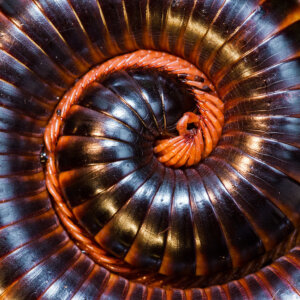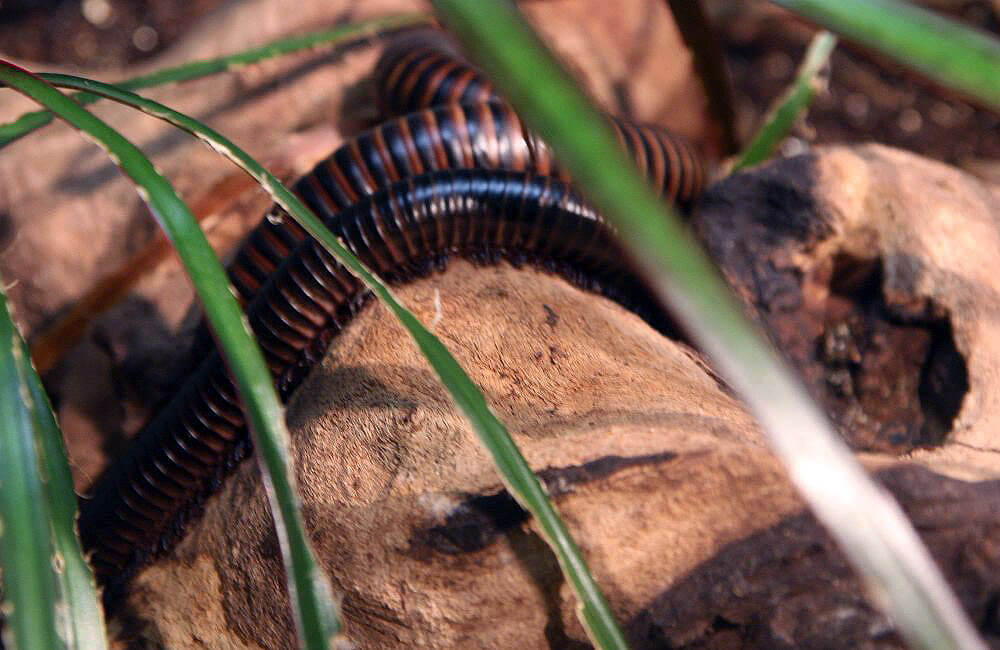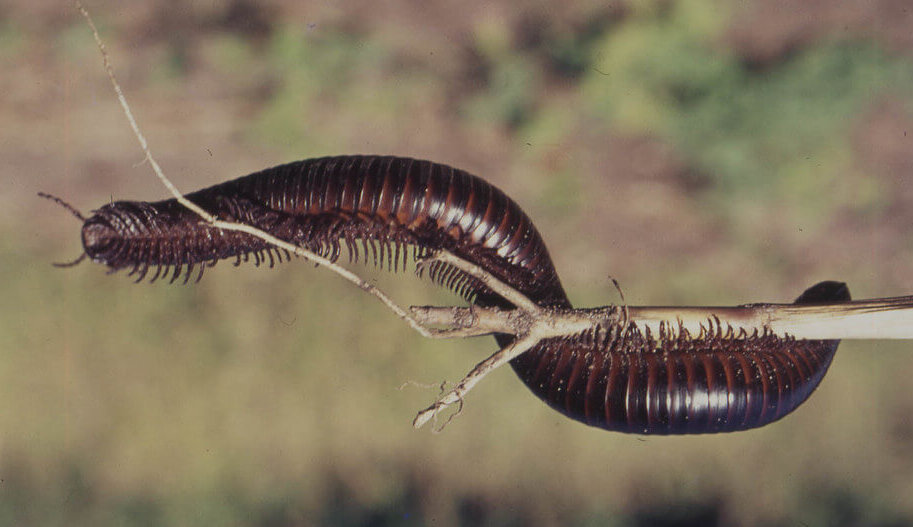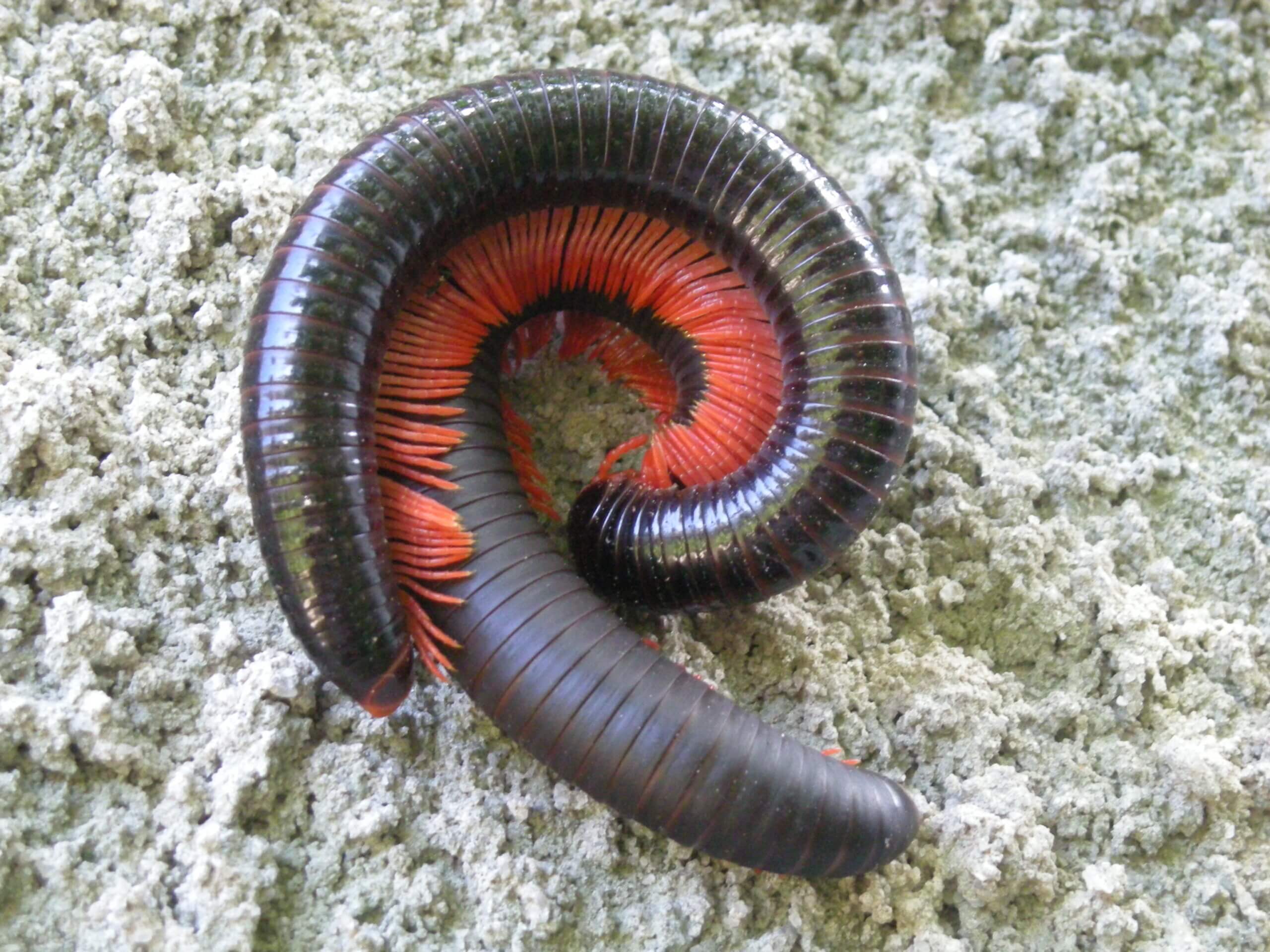Giant African Millipede: Habitat, Characteristics and Curiosities


Written and verified by the biologist Cesar Paul Gonzalez Gonzalez
The giant African millipede is considered the largest myriapod in the world, as its elongated body easily exceeds that of other types of millipedes. It’s a terrestrial animal that usually crawls on the ground thanks to its large number of legs. It isn’t dangerous or aggressive, so some people even consider it as a choice for a pet!
The scientific name of the species is Archispirostreptus gigas and it belongs to the group of myriapods, where all organisms called millipedes are found. Contrary to what it seems, it is not part of groups pertaining to insects or centipedes, although both taxa are closely related. Read on and find out more about the giant African millipede.
Habitat and distribution
As its name suggests, the giant African millipede is distributed over a wide area of East Africa. It can be found from Mozambique to Kenya, but mostly in areas close to the coast. They mainly inhabit arboreal ecosystems with high humidity, but also have the ability to withstand dry or arid environments.

Physical characteristics of the species
The body of the millipede is characterized by several ring-shaped sections. They usually have more than 100 divisions during their lifetime, which allows them to measure about 24 centimeters (just under 10 inches) in length. In addition, each of these rings has two pairs of legs. This means that they don’t have a thousand legs, but just over 200.
Thanks to its body structure, the millipede has great flexibility that allows it to climb different surfaces without any problems. For this reason, many people confuse it with a giant worm. Of course, this is only in appearance, as myriapods have a hardened exoskeleton and not flaccid skin as worms do.
The coloration of the African giant millipede is usually dark, but with reddish ring edges. However, due to its wide distribution, you can also find it in other lighter shades and different from the normal pattern.

Behavior
Millipedes tend to be most active at night, as this is when they can remain unnoticed by predators. Although they have a large number of legs, their movement is too slow and they aren’t able to escape easily. Therefore, in the daytime, they become easy prey for agile animals such as birds.
Feeding
The diet of the giant African millipede is based mainly on consuming decaying plant debris, such as leaf, vegetable, fruit, and plant remains. Thanks to this, they help recycle nutrients from the ecosystem. However, the species has certain opportunistic behaviors, as if it finds the remains of an insect it’s likely to feed on them.
Reproduction
The courtship of this millipede is quite simple, as they only align their body with that of the female and vibrate their legs as if it were an invitation to mate. At this point, the potential mate can either reject the request or, on the contrary, accept and begin the sperm transfer.
During this process, both specimens “embrace” and entwine each other. Thanks to this, the female is fertilized and in 3 or 4 weeks she’ll begin to lay her eggs, so she must quickly look for a nest for her young. Finally, the mother will take care of her young until they hatch and each one can fend for itself.

Millipedes as pets
Millipedes don’t require much care and their diet can be based on fruits and vegetables. For this reason, some people have chosen to have them as pets. However, certain countries have placed restrictions on their importation, as they’re considered an invasive species capable of seriously affecting ecosystems.
If you’re interested in keeping a giant African millipede as a pet, first check if you need a legal permit in your country. If you already have one, or if there’s no prohibition, you should consider the following aspects:
- Terrarium: This should contain vegetation, soil, and wood. Don’t forget to offer reliefs and slopes that it can climb on its own, as well as some raised areas and caves. The minimum dimensions for its habitat should be 60 centimeters (24 inches) long, 40 centimeters wide (16 inches) and 40 centimeters high.
- Temperature: This species comes from a warm climate, so the temperature of its home shouldn’t drop below 25 degrees Celsius (77 Fahrenheit).
- Humidity: In the same way, humidity is a very common component in its natural habitat, so, in captivity, it should be maintained at a minimum of 80%.
- Food: It’s enough to give it vegetable scraps, leaves, fruits, and vegetables.
Giant African millipede curiosities
Despite having a small and uninteresting body at first glance, there are several curiosities about the giant African millipede. Some of them are the following.
Defense mechanism
Although they don’t have complex behavior, millipedes have developed a unique defense mechanism. This consists of curling up on itself to protect its head, so that if its body is injured, it’s still able to survive. Also, in this position, they begin to secrete an irritating substance all over their body.
The liquid it emanates is intended to deter its aggressor, so it doesn’t cause noticeable damage. In fact, if a person comes into contact with the irritant, he or she will only have mild symptoms of itching and inflammation. However, the effects are more aggressive on delicate areas such as the inside of the mouth or eyes.
Mite friends
Giant African millipedes have a very close relationship with mites. In fact, the small arthropods often stay on the myriapod’s body to clean it. In exchange for this service, the millipede protects it and provides transportation.
Despite having a rather frightening and unfriendly appearance, African giant millipedes have quite an interesting body. Although they aren’t a cuddly species, there’s no denying their important role in the ecosystem as nutrient recyclers.
All cited sources were thoroughly reviewed by our team to ensure their quality, reliability, currency, and validity. The bibliography of this article was considered reliable and of academic or scientific accuracy.
- Šustr, V., Tajovský, K., Semanová, S., Chronakova, A., & Simek, M. (2013). The giant African millipede, Archispirostreptus gigas (Diplopoda: Spirostreptida), a model species for ecophysiological studies. Acta Soc Zool Bochem, 77, 145-158.
- Farfan, M. A., & Klompen, H. (2012). Phoretic mite associates of millipedes (Diplopoda, Julidae) in the northern Atlantic region (North America, Europe). International Journal of Myriapodology (Pensoft Publishers), 7.
- Mitchell, M., & Tully, T. N. (2008). Manual of exotic pet practice. Elsevier Health Sciences.
- Salmane, I. N. E. T. A., & Telnov, D. (2007). Laelaptidae mites (Parasitiformes, Mesostigmata) of east African millipedes (Diplopoda). Latvijas entomologs, 44, 121.
This text is provided for informational purposes only and does not replace consultation with a professional. If in doubt, consult your specialist.